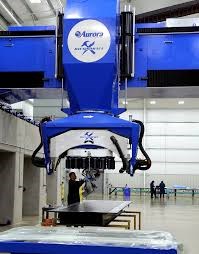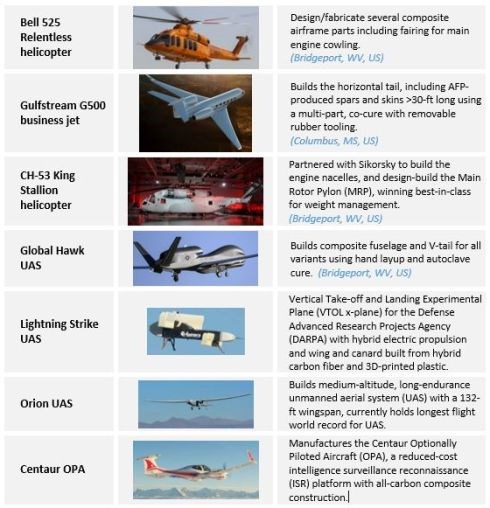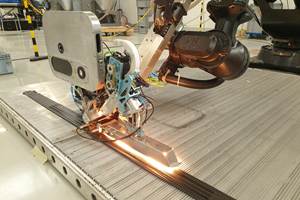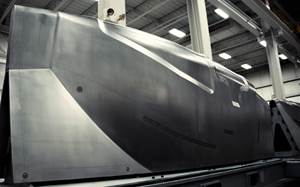Cost-effective aerocomposites: Dry fiber AFP and resin infusion
Aurora Flight Sciences and NONA Composites aim to improve toughness, repeatable aerospace quality and affordability for large-scale NASA structures.
Working on Phase II of a Small Business Innovation Research (SBIR) program for NASA Marshall Space Flight Center (Huntsville, AL, US), NONA Composites (Dayton, OH, US) and parent company Cornerstone Research Group (Dayton, OH, US), have subcontracted Aurora Flight Sciences (Manassas, VA, US) to demonstrate automated fiber placement (AFP) of dry tape and dry tape/prepreg hybrids for vacuum infusion processing.
“The combination of NONA’s room temperature infusion and flexible curing epoxy resins with dry tape reinforcements allows for lower cost raw materials and curing compared to prepreg,” says NONA Composites president Ben Dietsch. He adds that automated fiber placement imparts significant control on the fiber preform prior to infusion. “The infusion preform has traditionally been a key source of part variability,” notes Dietsch. AFP also automates fabrication of large-scale structures. “Our goal is to demonstrate the combination of these technologies, and their ability to cut costs and improve repeatability in large out of autoclave composites.”

|

|
Aurora Flight Sciences will use this 7-axis Electroimpact AFP) machine in its Columbus, Mississippi facility to build preforms from dry fiber tape and dry tape/prepreg hybrids which will be infused with NONA Composites room-temp cure epoxy resin.
SOURCE: Aurora Flight Sciences.
The overall goal of the program is to tackle some of the technical and operational hurdles with acceptance of infusion processing for aerospace parts, namely, improving part toughness of a room-temperature infused structure and demonstrating affordable, repeatable manufacturing at the large geometric scale required by NASA. “Toughness is a limiting factor in the design of aerospace structures,” explains Dietsch. “Traditionally, it has been more difficult to achieve the same toughness with resin-infused dry preforms as is possible with toughened prepregs cured in an autoclave.” NONA Composites and CRG, however, are pursuing two paths to rectify this. The first is through resin chemistry, the results of which NONA Composites will present at the 2016 CAMX (Sep. 26-29, Anaheim, CA, US). The second route is using thermoplastic veil materials in the dry fiber AFP, which not only adds toughness but also prevents material slippage during laydown. I wrote about this in my 2014 article on the MS-21’s resin-infused wings:
|
AeroComposit’s R&D lab tested many detail and element samples to help define this balance. It also evaluated many materials. “We tested materials with an open structure to help resin flow, as well as more closed materials, which relied on other means for permeability, such as ensured clearance between tapes,” says Gaidansky. Tapes, rather than hand-layed pieces of noncrimp fabric, were used because they could produce precision details with consistent speed through the use of an automated dry stack layup process." “Dry material, by definition, is not impregnated with any sticky resin, and thus easily moves from the position in which it is layed down,” explains MTorres sales director Juan Solano. “Our challenge was to somehow make the material stay in place to enable accurate machine-automated fiber location and ensure that this does not change after the fiber has been layed.” The solution? A very thin, lightweight thermoplastic veil functions as a binder during automated dry fiber placement. During layup the veil provides enough tack to affix the fiber. … The veil also provides a grid structure that increases resin flow and contributes to the desired compression-after-impact and interlaminar-shear-strength properties. |
For more details, read the full article, and also “Dry fiber placement: Surpassing limits” and “FACC: Aerospace infusion pioneer”
In order to make headway in demonstrating affordable and repeatable large structures, NONA Composites needed to partner with a parts manufacturer, and preferably one that was interested in working to develop new technology. “We’re excited to work with Aurora Flight Sciences,” says Dietsch. “Not only are they well-versed in the demands of aerospace composite structures production and out-of-autoclave processing, but they also have a lot of experience with SBIR development work and are very forward-thinking.” He adds that Aurora’s AFP equipment is also very similar to that at NASA Marshall Space Flight Center, and the two facilities are within easy driving distance of each other. “So we know anything we learn from the work at Aurora, NASA could implement easily,” says Dietsch.
NASA will reportedly build the biggest composite rocket parts ever made using this robotic system, part of the Composites Technology Center at NASA’s Marshall Space Flight Center in Huntsville, Alabama. SOURCE: NASA.
Aurora Flight Sciences will be performing this SBIR work in their Columbus, Mississippi facility, which houses a state-of-the-art 7-axis high rail gantry Electroimpact AFP machine with heads capable of laying half-inch and quarter-inch wide slit tape. Dr. Konstantine Fetfatsidis, director of advanced composites programs at Aurora, says his company is looking forward to this development work with NONA and CRG, “and to demonstrate a relatively new approach to cost-competitiveness in composites fabrication which leverages our investments in this area.”
Part of the collaboration will involve benchmarking the new technology against existing Aurora AFP production efforts. As projected performance and cost benefits are realized, the team will also be reaching out to potential OEM partners for further collaboration. These Phase II Enhancement efforts can be cost-shared by the NASA SBIR program. Ben Dietsch and Konstantine Fetfatsidis will both be participating in a panel session on out-of–autoclave technology at the upcoming SAMPE Conference and Exhibition (May 23-27, Long Beach, CA, US) and will discuss the technology in this development program during that event.
Below is a brief background on Aurora Flight Sciences. To me it shows not only that Aurora is a very interesting player in composite aerostructures but also a good choice for NONA Composites’ partner in this OOA AFP development work.
Aurora Flight Sciences
A Tier 1 supplier of composite structures for both the commercial and military aerospace markets, Aurora Flight Sciences is also an OEM. It provides a full range of services as a fabricator, including conceptual design development, testing and first part qualification/certification and also delivers complete assemblies with integrated subsystems such as pneumatics, fuel and air lines, and avionics. Aurora’s Aerostructures group specializes in complex design, build-to-print and rapid prototyping of airframes from both advanced composites and metals.
Headquartered in Manassas, VA, Aurora operates production plants in Bridgeport, West Virginia and Columbus, Mississippi. The company also has a Research and Development Center in Cambridge, Massachusetts, and a recently opened office in Mountain View, California.
Current programs include:
Aurora was also awarded a variety of Small Business Innovation Research (SBIR) grants in 2015, including several directly related to composites:
- Automated Manufacture of Damage Detecting, Self-Healing Composite Cryogenic Pressure Vessels
- Benefit Analysis of Hybrid CNT/CFRP Composites in Future Aircraft Structures
- In-situ Sensing for Multi-Functional Structures.
Related Content
Plant tour: Joby Aviation, Marina, Calif., U.S.
As the advanced air mobility market begins to take shape, market leader Joby Aviation works to industrialize composites manufacturing for its first-generation, composites-intensive, all-electric air taxi.
Read MoreATLAM combines composite tape laying, large-scale thermoplastic 3D printing in one printhead
CEAD, GKN Aerospace Deutschland and TU Munich enable additive manufacturing of large composite tools and parts with low CTE and high mechanical properties.
Read MoreNine factors to consider when designing composites cure tooling
Gary Bond discusses the common pitfalls and compromises when designing good cure tooling and their holistic significance for a robust composite production process.
Read MoreCombining multifunctional thermoplastic composites, additive manufacturing for next-gen airframe structures
The DOMMINIO project combines AFP with 3D printed gyroid cores, embedded SHM sensors and smart materials for induction-driven disassembly of parts at end of life.
Read MoreRead Next
VIDEO: High-rate composites production for aerospace
Westlake Epoxy’s process on display at CAMX 2024 reduces cycle time from hours to just 15 minutes.
Read MorePlant tour: A&P, Cincinnati, OH
A&P has made a name for itself as a braider, but the depth and breadth of its technical aptitude comes into sharp focus with a peek behind usually closed doors.
Read More“Structured air” TPS safeguards composite structures
Powered by an 85% air/15% pure polyimide aerogel, Blueshift’s novel material system protects structures during transient thermal events from -200°C to beyond 2400°C for rockets, battery boxes and more.
Read More
























